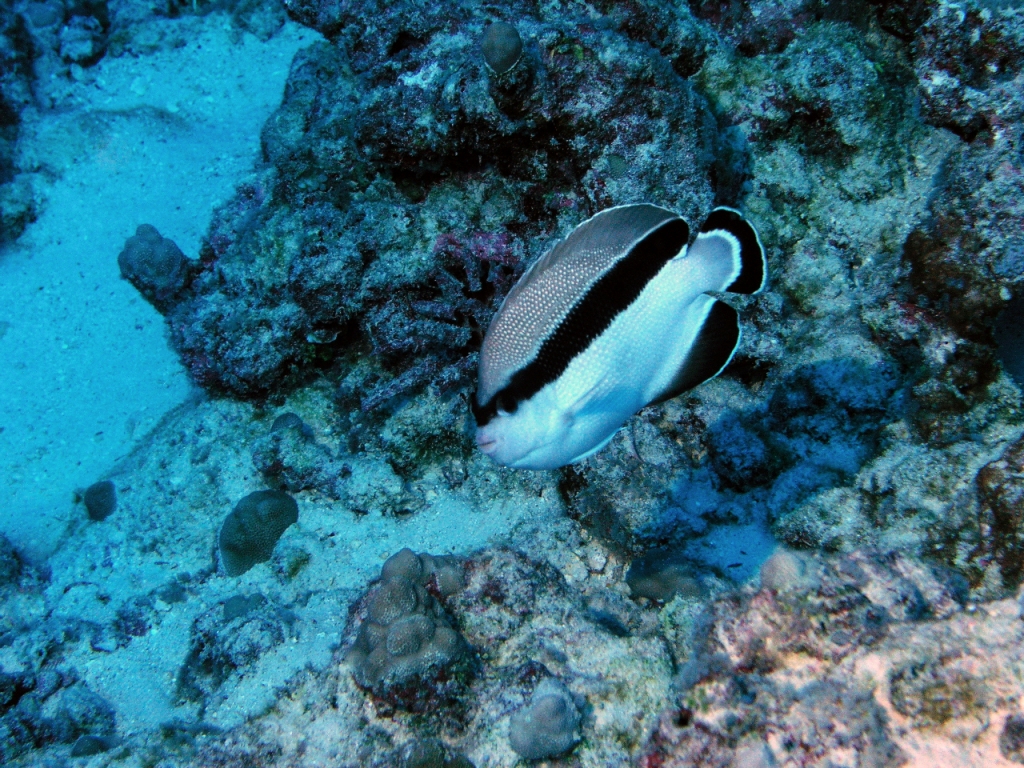Habitat and Adaptions
The habitat of the black banded angelfish
fails to reach too far from the Hawaiian Islands.
Only two other islands have been found to be hosts of
this species of angelfish.
These two places are Johnston and Midway Atoll (Island);
both located in the Pacific North, west of the Hawaiian Islands.
30% of the reef fishes located in this region are
limited to this isolated habitat making these islands
 more
attractive to ocean goers.
However, this isolation ultimately leaves the bandit
fish, as well as all the other fish like this, at a disadvantage
when compared to fish that inhabit a greater number of
locations. This
disadvantage is due to the small genetic difference between fish
in a single species caused by years of isolated breeding leaving
them vulnerable to disease, and therefore, at risk as a
population if a pathogenic disease
more
attractive to ocean goers.
However, this isolation ultimately leaves the bandit
fish, as well as all the other fish like this, at a disadvantage
when compared to fish that inhabit a greater number of
locations. This
disadvantage is due to the small genetic difference between fish
in a single species caused by years of isolated breeding leaving
them vulnerable to disease, and therefore, at risk as a
population if a pathogenic disease
.jpg) did
ever present itself.
Not only is the bandit angelfish at risk to disease, but it also
is capable of hosting an organism that poses a threat against humans.
It, along with hundreds of other reef fish, can carry a
toxic
protist
that exists in the fish after the consumption of a
infected algae.
Humans then eat
these fish, or eat a larger predator that had already consumed
the fish, and become ill.
did
ever present itself.
Not only is the bandit angelfish at risk to disease, but it also
is capable of hosting an organism that poses a threat against humans.
It, along with hundreds of other reef fish, can carry a
toxic
protist
that exists in the fish after the consumption of a
infected algae.
Humans then eat
these fish, or eat a larger predator that had already consumed
the fish, and become ill.
Living in a coral reef and being in the middle of the food
chain, the bandit angelfish is at an advantage when finding its
wide array of
food; however, it is still has
its disadvantages, one being due to reef
predators. There are
many predators that find the bandit angelfish to be a colorful,
delicious meal. Another
disadvantage the bandit angelfish has is due to the depletion of
the coral reef populations.
Currently, the world’s coral reefs are being destroyed at
such a high rate that 70% of them throughout the world will be
non-existent within the next two decades!
A very large number of fish species only reside in the
ecosystem created by coral reefs and with the reefs depleting,
what will be of these organisms in the future?
Reef.jpg) depletion is being caused by numerous factors;
however the main contributors are disease amongst the reef
itself, overharvesting of the reef, and the increasing
temperature of oceanic waters.
depletion is being caused by numerous factors;
however the main contributors are disease amongst the reef
itself, overharvesting of the reef, and the increasing
temperature of oceanic waters.
The bandit angelfish has also adapted
multiple traits to best suit it for its reef environment.
One adaption is the presence and structure of its
numerous fins. It
has 13 dorsal spines, 17-18 dorsal soft rays, three anal spines
and 18 anal soft rays.
The dorsal spines and rays are primarily for protection
and prevention of rolling while anal spines and rays function to
propel the fish as well as stabilize it while in locomotion.
Along with these, the bandit angelfish also has pectoral
fins on both sides that control up and down motions, side to
side motions, rolling motions, as well as increasing how
aerodynamic the fish is (increasing or decreasing speed).
Below these pectoral fins are similarly looking ventral
fins. These fins are
specialized for turning, elevation, descending, and stopping.
Each fin has a specific function that contributes to the
complex movement of the bandit angelfish.
The next adaption the bandit fish has is its unique color
scheme. The mid to
low body of the fish is white, followed by the distinctive inch
thick black band above it, with everything else above the band
being brown. Its
dorsal spines and rays are brown, while its anal spines and rays
are white with a black band, of similar thickness to the one on its body, along their edges. The pectoral and ventral fins are white just like the
body. Overall, this
coloration helps the fish blend into many different
environmental color schemes.
This enables it to be camouflaged when being sought after
by predators.
on its body, along their edges. The pectoral and ventral fins are white just like the
body. Overall, this
coloration helps the fish blend into many different
environmental color schemes.
This enables it to be camouflaged when being sought after
by predators.
The bandit’s final adaption comes with its bodily size and shape. It has a very slender appearance enhancing its ability to hide from predators. Also, it is fairly small, only growing to a maximum size of 18 cm as an adult, thus enabling it to maneuver around the reefs without worrying about fitting in tight spaces. The small size of this fish also helps with consumption of the organisms on its diet.